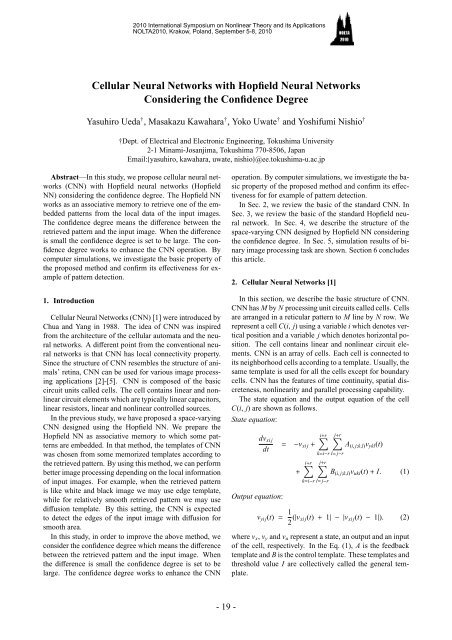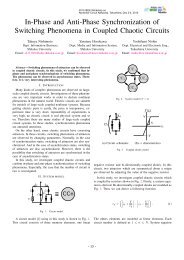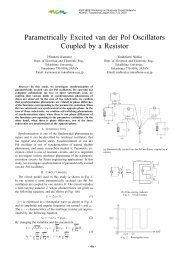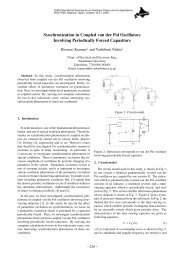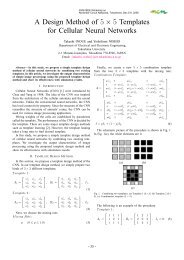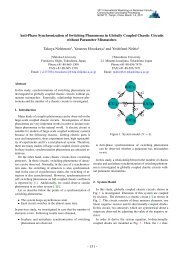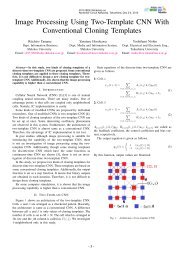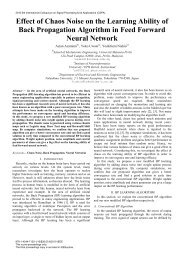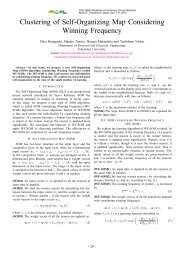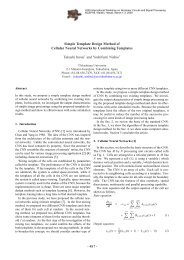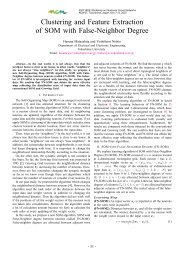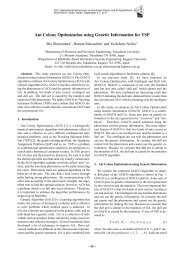Cellular Neural Networks with Hopfield Neural Networks ...
Cellular Neural Networks with Hopfield Neural Networks ...
Cellular Neural Networks with Hopfield Neural Networks ...
Create successful ePaper yourself
Turn your PDF publications into a flip-book with our unique Google optimized e-Paper software.
2010 International Symposium on Nonlinear Theory and its Applications<br />
NOLTA2010, Krakow, Poland, September 5-8, 2010<br />
<strong>Cellular</strong> <strong>Neural</strong> <strong>Networks</strong> <strong>with</strong> <strong>Hopfield</strong> <strong>Neural</strong> <strong>Networks</strong><br />
Considering the Confidence Degree<br />
Yasuhiro Ueda † , Masakazu Kawahara † , Yoko Uwate † and Yoshifumi Nishio †<br />
†Dept. of Electrical and Electronic Engineering, Tokushima University<br />
2-1 Minami-Josanjima, Tokushima 770-8506, Japan<br />
Email:{yasuhiro, kawahara, uwate, nishio}@ee.tokushima-u.ac.jp<br />
Abstract—In this study, we propose cellular neural networks<br />
(CNN) <strong>with</strong> <strong>Hopfield</strong> neural networks (<strong>Hopfield</strong><br />
NN) considering the confidence degree. The <strong>Hopfield</strong> NN<br />
works as an associative memory to retrieve one of the embedded<br />
patterns from the local data of the input images.<br />
The confidence degree means the difference between the<br />
retrieved pattern and the input image. When the difference<br />
is small the confidence degree is set to be large. The confidence<br />
degree works to enhance the CNN operation. By<br />
computer simulations, we investigate the basic property of<br />
the proposed method and confirm its effectiveness for example<br />
of pattern detection.<br />
1. Introduction<br />
<strong>Cellular</strong> <strong>Neural</strong> <strong>Networks</strong> (CNN) [1] were introduced by<br />
Chua and Yang in 1988. The idea of CNN was inspired<br />
from the architecture of the cellular automata and the neural<br />
networks. A different point from the conventional neural<br />
networks is that CNN has local connectivity property.<br />
Since the structure of CNN resembles the structure of animals’<br />
retina, CNN can be used for various image processing<br />
applications [2]-[5]. CNN is composed of the basic<br />
circuit units called cells. The cell contains linear and nonlinear<br />
circuit elements which are typically linear capacitors,<br />
linear resistors, linear and nonlinear controlled sources.<br />
In the previous study, we have proposed a space-varying<br />
CNN designed using the <strong>Hopfield</strong> NN. We prepare the<br />
<strong>Hopfield</strong> NN as associative memory to which some patterns<br />
are embedded. In that method, the templates of CNN<br />
was chosen from some memorized templates according to<br />
the retrieved pattern. By using this method, we can perform<br />
better image processing depending on the local information<br />
of input images. For example, when the retrieved pattern<br />
is like white and black image we may use edge template,<br />
while for relatively smooth retrieved pattern we may use<br />
diffusion template. By this setting, the CNN is expected<br />
to detect the edges of the input image <strong>with</strong> diffusion for<br />
smooth area.<br />
In this study, in order to improve the above method, we<br />
consider the confidence degree which means the difference<br />
between the retrieved pattern and the input image. When<br />
the difference is small the confidence degree is set to be<br />
large. The confidence degree works to enhance the CNN<br />
operation. By computer simulations, we investigate the basic<br />
property of the proposed method and confirm its effectiveness<br />
for for example of pattern detection.<br />
In Sec. 2, we review the basic of the standard CNN. In<br />
Sec. 3, we review the basic of the standard <strong>Hopfield</strong> neural<br />
network. In Sec. 4, we describe the structure of the<br />
space-varying CNN designed by <strong>Hopfield</strong> NN considering<br />
the confidence degree. In Sec. 5, simulation results of binary<br />
image processing task are shown. Section 6 concludes<br />
this article.<br />
2. <strong>Cellular</strong> <strong>Neural</strong> <strong>Networks</strong> [1]<br />
In this section, we describe the basic structure of CNN.<br />
CNN has M by N processing unit circuits called cells. Cells<br />
are arranged in a reticular pattern to M line by N row. We<br />
represent a cell C(i, j) using a variable i which denotes vertical<br />
position and a variable j which denotes horizontal position.<br />
The cell contains linear and nonlinear circuit elements.<br />
CNN is an array of cells. Each cell is connected to<br />
its neighborhood cells according to a template. Usually, the<br />
same template is used for all the cells except for boundary<br />
cells. CNN has the features of time continuity, spatial discreteness,<br />
nonlinearity and parallel processing capability.<br />
The state equation and the output equation of the cell<br />
C(i, j) are shown as follows.<br />
State equation:<br />
dv xi j<br />
dt<br />
Output equation:<br />
= −v xi j +<br />
+<br />
∑i+r<br />
∑i+r<br />
k=i−r l= j−r<br />
∑j+r<br />
k=i−r l= j−r<br />
∑j+r<br />
A (i, j;k,l) v ykl (t)<br />
B (i, j;k,l) v ukl (t) + I. (1)<br />
v yi j (t) = 1 2 (|v xi j(t) + 1| − |v xi j (t) − 1|). (2)<br />
where v x , v y and v u represent a state, an output and an input<br />
of the cell, respectively. In the Eq. (1), A is the feedback<br />
template and B is the control template. These templates and<br />
threshold value I are collectively called the general template.<br />
- 19 -
The r-neighborhood of C(i, j) in CNN is defined by<br />
Nr(i, j) = {C(k, l) | max { |k − i| , |l − j| } ≤ r,<br />
1 ≤ k ≤ M; 1 ≤ l ≤ N}. (3)<br />
where r is a positive integer number. In our study, we fix<br />
the value of r as 1.<br />
3. <strong>Hopfield</strong> <strong>Neural</strong> Network Working as Associative<br />
Memory<br />
In this section, we describe the basic structure of <strong>Hopfield</strong><br />
<strong>Neural</strong> Network (<strong>Hopfield</strong> NN). Associative memory<br />
is a system which returns a stored pattern or its reversed<br />
pattern that is similar to an inputted pattern. Noisy patterns<br />
can be associated or distorted patterns can be recognized<br />
by a well-constructed associative memory.<br />
The <strong>Hopfield</strong> NN is used as an associative memory by<br />
exploiting the property that the network has multiple stable<br />
states. Namely, if the parameters of the network can<br />
be decided in such a way that the patterns to be stored become<br />
stable states of the network, the network produces a<br />
stored pattern that is similar to an input pattern. The energy<br />
function of the <strong>Hopfield</strong> NN <strong>with</strong> N neurons and P stored<br />
binary patterns is defined by the following equation.<br />
E = − 1 2<br />
N∑ N∑<br />
N∑<br />
w i j x i x j + θ i x i , (4)<br />
i=1<br />
j=1<br />
where w i j is the weight between i-th neuron and j-th neuron,<br />
and θ i is the threshold of the i-th neuron. The weight<br />
w i j is given as follows.<br />
w i j =<br />
i=1<br />
{ ∑ Pp=1<br />
x (p) (p) i x j (i j)<br />
0. (i = j)<br />
The weight w i j is 0 when i = j, because all the units have<br />
combined <strong>with</strong> all the units of the others except themselves<br />
The states of the neurons are asynchronously updated due<br />
to the following difference equation:<br />
(5)<br />
∑<br />
x i (t + 1) = sgn( w i j x j (t)), (6)<br />
i j<br />
where sgn is an output function as follows:<br />
{<br />
sgn(a) =<br />
1 (a ≥ 0)<br />
−1. (a < 0)<br />
4. Space-Varying <strong>Cellular</strong> <strong>Neural</strong> <strong>Networks</strong> Considering<br />
the Confidence Degree<br />
In the previous study, we have proposed space-varying<br />
cellular neural networks which is designed by using the<br />
(7)<br />
ability of the associative memory of <strong>Hopfield</strong> NN. In general,<br />
the design of space-varying systems is not easy. However,<br />
we can set one of prepared existing templates on<br />
each cell of CNN according to the retrieved pattern by<br />
<strong>Hopfield</strong> NN to which some typical local image structures<br />
are embedded. Namely, we need only some existing templates<br />
and their associated patterns. The design method<br />
is described as follows. Firstly, we prepare some twodimensional<br />
arbitrary patterns for the memory of <strong>Hopfield</strong><br />
NN and some existing templates related <strong>with</strong> these patterns,<br />
respectively. Secondly, <strong>Hopfield</strong> NN memorize the<br />
some two-dimensional arbitrary patterns. Thirdly, <strong>Hopfield</strong><br />
NN compare between memorized the some arbitrary patterns<br />
and each pixel and its two neighborhood pixels of a<br />
input image. Hence, from some arbitrary patterns, <strong>Hopfield</strong><br />
NN associate the certain arbitrary pattern which is the most<br />
similar to the pattern of each pixel and its two neighborhood<br />
pixels. Fourth, from the prepared some existing templates,<br />
the template of each cell in CNN is designed based<br />
on the associated pattern. Finally, input image is processed<br />
by using the space-varying CNN designed by <strong>Hopfield</strong> NN.<br />
Each templates are applied to each cell by these steps.<br />
In this study, we propose the developing system by considering<br />
the confidence degree to space-varying CNN. We<br />
calculate the Hamming difference between the retrieved<br />
pattern and the input image. When the Hamming difference<br />
is small the confidence degree is set to be large. The<br />
confidence degree works to enhance the CNN operation.<br />
By using this system, it is possible to detect the some objects<br />
by changing the threshold value when several similar<br />
objects exist in the input image. The threshold value I cd<br />
is defined as following in Eq. 8 and the characteristics of<br />
the threshold value I cd <strong>with</strong> the Hamming distance and the<br />
confidence degree is shown in Fig. 1.<br />
I cd =<br />
13 × Con f idence Degree[%]<br />
100(1 + exp(HD))<br />
In Eq. (8), HD is calculated by Eq. (9), and<br />
Con f idence Degree[%] is a parameter to change the<br />
characteristics of the threshold value I cd .<br />
HD =<br />
5. Simulation Results<br />
−1 × Hamming Distance + 13<br />
5<br />
In order to confirm the effectiveness of this proposed<br />
method, the CNN application of the object detection is simulated.<br />
In this simulation, we use “Logic AND” template.<br />
This template reads out the black when input value and initial<br />
value are black. The others situation, the output becomes<br />
white. Therefore, when the input image and the initial<br />
state are same, the output is same <strong>with</strong> input image.<br />
However, if the threshold value of “Logic AND” template<br />
(8)<br />
(9)<br />
- 20 -
5<br />
4<br />
Threshold Value Icd<br />
3<br />
2<br />
1<br />
50 %<br />
70 %<br />
0<br />
0 1 2 3 4 5 6 7 8 9 10 11 12 13<br />
Hamming distance<br />
Figure 1: Change of the threshold value I cd by the confidence<br />
degree.<br />
80 %<br />
Figure 3: Input binary image to CNN and <strong>Hopfield</strong> NN.<br />
Moreover, by changing the confidence degree which is<br />
50 [%], 70 [%] and 80 [%], the extra threshold value I cd<br />
is decided like Eq. 8 and Fig. 1. State equation of CNN<br />
updated is described as follows.<br />
is changed smaller than -2.1, CNN outputs white regardless<br />
of the input image and the initial state.<br />
In this section, we show some simulation results using<br />
the proposed CNN. The input binary image is 4 and its size<br />
is 64 by 64. First, we describe the memorized patterns and<br />
related templates. And templates are found in [8].<br />
dv xi j<br />
dt<br />
= −v xi j +<br />
+<br />
∑i+r<br />
∑i+r<br />
k=i−r l= j−r<br />
∑j+r<br />
k=i−r l= j−r<br />
∑j+r<br />
A n(i, j;k,l) v ykl (t)<br />
B n(i, j;k,l) v ukl (t) + I − I cd . (12)<br />
Figure 2: Memorized patterns.<br />
“Logic AND” template:<br />
⎡ ⎤<br />
0 0 0<br />
A = 0 2 0 ⎢⎣ ⎥⎦<br />
⎡⎢⎣<br />
, B = 0 0 0<br />
0 0 0<br />
0 1 0<br />
0 0 0<br />
⎤<br />
, I = −1. (10)<br />
⎥⎦<br />
By using the extra threshold value I cd , simulation results<br />
are changed as shown in Fig. 4 (a), (b) and (c), respectively.<br />
Therefore, some points of the object are detected by changing<br />
the confidence degree. Additionally, some points which<br />
have same pattern <strong>with</strong> memorized pattern is detected irrespectively<br />
the confidence degree.<br />
“White filler” template:<br />
⎡ ⎤<br />
0 0 0<br />
A = 0 2 0 , B = 0, I = −4. (11)<br />
⎢⎣ ⎥⎦<br />
0 0 0<br />
This template of Eq. (11) changes all outputs into -1.<br />
The memorized patterns are set as shown in Fig. 2. Four<br />
patterns which are Fig. 2 from the left are related <strong>with</strong><br />
“Logic AND” template. These patterns corresponds to the<br />
part of objects in the input image. The rightmost pattern is<br />
related <strong>with</strong> “White Filler” template. This pattern describe<br />
the uniform region. By using these patterns, wiring weights<br />
of <strong>Hopfield</strong> NN is decided and each templates are applied<br />
to each cells.<br />
(a) (b) (c)<br />
Figure 4: Output image by using proposed system.<br />
(a) Confidence degree is 50 [%]. (b) Confidence degree<br />
is 70 [%]. (c) Confidence degree is 80 [%].<br />
By using this system, we detected some points of each<br />
objects. Additionally, by changing the confidence degree,<br />
the number of the detected points are changed. Moreover,<br />
we carry out “Recall” template <strong>with</strong> conventional CNN to<br />
Fig. 4.<br />
- 21 -
The Number of Detected Points<br />
110<br />
100<br />
90<br />
80<br />
70<br />
60<br />
50<br />
40<br />
30<br />
20<br />
10<br />
0<br />
0 10 20 30 40 50 60 70 80 90 100 110<br />
Confidence Degree [%]<br />
Figure 5: Change of detected points by Confidence degree.<br />
“Recall” template:<br />
⎡<br />
A = ⎢⎣<br />
0.3 0.3 0.3<br />
0.3 4 0.3<br />
0.3 0.3 0.3<br />
⎤<br />
⎥⎦ , B = ⎡⎢⎣<br />
0 0 0<br />
0 5.1 0<br />
0 0 0<br />
Simulation results are shown as follows (Fig. 6).<br />
(a) (b) (c)<br />
⎤<br />
⎥⎦ , I = 0.<br />
(13)<br />
Figure 6: Output image by applying the “Recall” template<br />
<strong>with</strong> conventional CNN to Fig. 4. (a) Recall the input image<br />
in Fig. 4 (a). (b) Recall the input image in Fig. 4 (b).<br />
(c) Recall the input image in Fig. 4 (c).<br />
From this simulation results, we can change the type of the<br />
detected objects by changing the confidence degree. Additionally,<br />
we could detect the object which is including the<br />
same pattern <strong>with</strong> the memorized pattern.<br />
pattern and the input image. When the difference was small<br />
the confidence degree was set to be large. The confidence<br />
degree worked to enhance the CNN operation. By computer<br />
simulations, we investigated the basic property of the<br />
proposed method and confirmed its effectiveness for several<br />
examples.<br />
References<br />
[1] L.O. Chua and L. Yang, “<strong>Cellular</strong> <strong>Neural</strong> <strong>Networks</strong>:Theory,”<br />
IEEE Trans. Circuits Syst., vol. 32,<br />
pp. 1257-1272, Oct. 1988.<br />
[2] F. Dirk and T. Ronald, “Coding of Binary Image Data<br />
using <strong>Cellular</strong> <strong>Neural</strong> <strong>Networks</strong> and Iterative Annealing,”<br />
Proc. of ECCTD’03, vol. 1, pp. 229-232, Sep.<br />
2003.<br />
[3] M. Namba and Z. Zhang, “<strong>Cellular</strong> <strong>Neural</strong> Network for<br />
Associative Memory and Its Application to Braille Image<br />
Recognition,” Proc. of IJCNN’06, pp. 4716-4721,<br />
Jul. 2006.<br />
[4] H. Koeppl and L.O. Chua, “An Adaptive <strong>Cellular</strong><br />
Nonlinear Network and its Application,” Proc. of<br />
NOLTA’07, pp. 15-18, Sep. 2007.<br />
[5] T. Kozek, K.R. Crounse, T. Roska and L.O. Chua,<br />
“Smart Image Scanning Algorithms for the CNN Universal<br />
Machine,” Proc. of NOLTA’95, vol. 2, pp. 707-<br />
712, 1995.<br />
[6] K. Sumitomo and A. Ushida, “A Design Method of<br />
<strong>Cellular</strong> <strong>Neural</strong> <strong>Networks</strong> using Fuzzy Inference,” IE-<br />
ICE Technical Report, NLP, vol. 98, no. 443, pp. 39-<br />
46, Dec, 1998.<br />
[7] J. J. <strong>Hopfield</strong>, “Neurons <strong>with</strong> Graded Response Have<br />
Collective Computational Properties like Those of<br />
Two-State Neurons,” Proc. Natl. Acad. Sci. USA, vol.<br />
81, pp. 3088-3092, 1984.<br />
[8] <strong>Cellular</strong> Sensory Wave Computers Laboratory Computer<br />
and Automation Research Institute Hungarian<br />
Academy of Sciences, “<strong>Cellular</strong> wave Computing Library<br />
(Template, Algorithms, and Programs) Version<br />
2.1”<br />
6. Conclusions<br />
In this study, we proposed cellular neural networks<br />
(CNN) <strong>with</strong> <strong>Hopfield</strong> neural networks (<strong>Hopfield</strong> NN) considering<br />
the confidence degree. The <strong>Hopfield</strong> NN worked<br />
as an associative memory to retrieve one of the embedded<br />
patterns from the local data of the input images. The confidence<br />
degree meant the difference between the retrieved<br />
- 22 -


